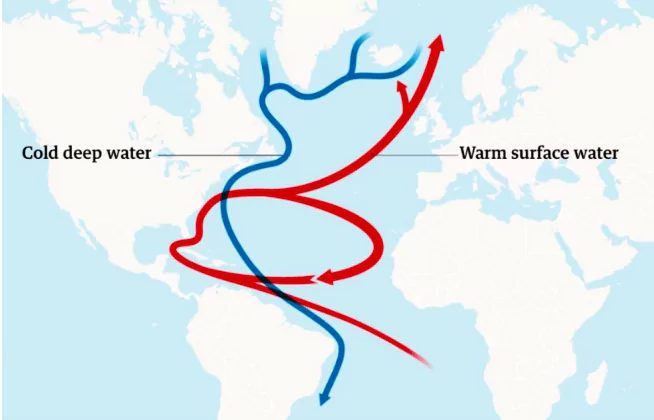Context:
A paper from scientists from the University of Copenhagen, Denmark published that Atlantic Meridional Overturning Circulation (AMOC) could collapse between 2025 and 2095 due to the impact of anthropogenic emissions.
- Based on the current rate of emissions, the collapse is likely to occur in the 2050s, the scientists say with 95% confidence in the study published in “Nature Communications”.
What is Atlantic Meridional Overturning Circulation?
- Atlantic Meridional Overturning Circulation is a large system of ocean currents that is regulated by differences between salt content, temperature, and water density of oceans. It is also referred to as the “ocean’s conveyor belt” due to its continuous movement of warm and cold water masses throughout the Atlantic Ocean.

-
Mechanism of Atlantic Meridional Overturning Circulation:
- Warm Water Transport: AMOC moves warm water from the tropics to the northern Atlantic Ocean basin.
- Cooling and Density Increase: As the water cools and becomes denser in the North Atlantic, it sinks to the ocean floor.
- Southward Flow: This deep, cold water then flows southward along the ocean bottom, eventually returning to the tropics to complete the cycle.
Importance Of Atlantic Meridional Overturning Circulation
- Temperature Regulation: The Atlantic Meridional Overturning Circulation plays a crucial role in regulating global temperatures by transporting heat from the tropics to the poles.
- Influence on Weather Patterns: It also influences regional weather patterns, including rainfall and storm tracks.
- Global Climate Impacts: A slowdown or AMOC collapse could have significant consequences for global climate, including changes in sea level, precipitation patterns, and extreme weather events.
Slowing Down of Atlantic Meridional Overturning Circulation
- Climate Change: Increased greenhouse gas concentrations lead to warming, impacting water density and stratification, thus potentially weakening the AMOC.
- Melting Glaciers and Ice Sheets: Freshwater influx from melting ice disrupts the salinity balance, reducing the density of surface water and hindering its sinking.
- Changes in Wind Patterns: Shifts in atmospheric circulation patterns, like increased westerly winds, can influence AMOC strength.
Impact of Atlantic Meridional Overturning Circulation Slow Down
- Altered Regional Climates: A weakened AMOC could lead to cooler winters in Europe and changes in precipitation patterns across the globe.
- A collapsed AMOC would cause widespread cooling across the northern hemisphere and less precipitation in places such as Europe, North America, China, and some parts of Russia in Asia.
- Sea Level Rise: Weakened circulation could lead to increased sea level rise along the US East Coast and other regions.
- Disruptions to Marine Ecosystems: Changes in ocean currents and temperatures could impact marine life distribution and abundance.
Conclusion
Scientists are continuing to study the Atlantic Meridional Overturning Circulation (AMOC) to better understand its dynamics and how it may be affected by climate change. This research is essential for developing strategies to mitigate the potential impacts of an AMOC collapse.
News Source: DTE
![]() 13 Feb 2024
13 Feb 2024

